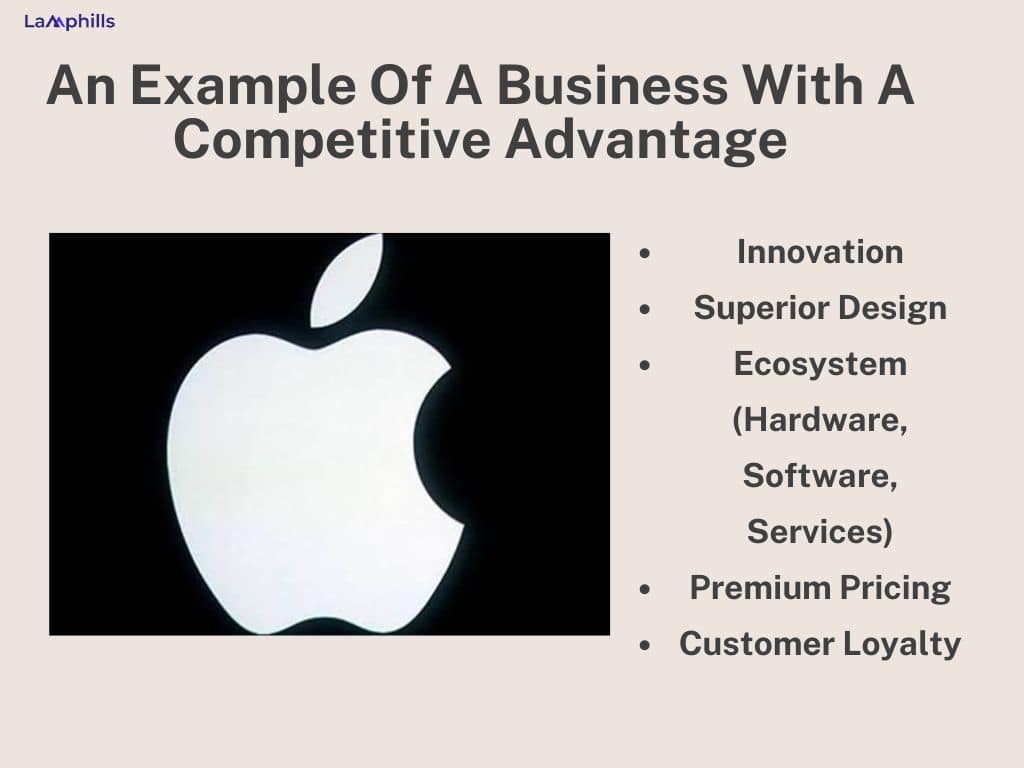Ever wondered what makes the top companies stand out from the rest? Let me tell you, it’s more than just good luck. Yeah! It’s about seizing opportunities and turning them into strengths. You know as the saying goes, “Competition is like a game of chess; to win, you must outmaneuver your opponent and stay steps ahead at all times.” That’s exactly what you need to do_ competitive advantage examples!
Well, I’ve done some digging, and I’m going to share nine sustainable competitive advantage examples that’ll help you stand out, whether you own a small business or a big company. Ready to know the secrets behind top companies’ success? Then, keep reading!
Key Points
- Competitive advantage examples are unique attributes or strategies that allow a company to outperform its competitors.
- Examples include cost leadership, differentiation through unique features or superior quality, and strong marketing and branding efforts.
- Embracing innovation helps companies stay ahead by adopting the latest technologies and setting industry trends.
- Strong marketing and branding efforts, like Nike’s, tell compelling stories and engage on social media, building deep consumer connections.
- Focusing on customer needs and providing excellent service fosters strong relationships and customer loyalty.
9 Competitive Advantage Examples
I understand how you want your company or business to be on top or better still stand out, and that’s why I have sustainable competitive advantage examples for you. Having a competitive advantage is crucial in today’s business world. It sets your company apart from competitors and allows you to attract and retain customers effectively. For these reasons, I have 9 sustainable competitive advantage examples that can help your small and big company or business achieve and maintain its position:
#1. Cost Leadership
Cost leadership is a strategic approach that businesses use to gain a position by becoming the lowest-cost producer in the industry. Essentially, it’s all about being able to offer products or services at a lower price than your competitors.
So, how does it work? Well, companies achieve cost leadership by finding ways to streamline their operations, reduce wastage, negotiate better deals with suppliers, and leverage economies of scale. If you cut down on production costs without compromising on quality, you can then pass on these savings to customers in the form of lower prices.
You know customers are naturally drawn to lower-priced options, especially in today’s price-sensitive market. By offering products or services at a more competitive price point, you can implement cost leadership that can attract a larger customer base and increase their market share.
#2. Differentiation
Another strategy is to differentiate your products or services from those of competitors. You can achieve it through unique features, superior quality, or exceptional customer service. Let’s assume you like coffee so much. Think about your favorite coffee shop. Maybe it’s not just the coffee itself that keeps you coming back, but also the cozy ambiance, friendly baristas, and maybe even their signature coffee blends you can’t find anywhere else. That’s differentiation in action – they’re offering something unique and special that sets them apart from other coffee chains.
Another example can be a clothing brand that uses sustainable materials or a technology company that offers exceptional customer support along with its products. These unique features or superior quality help them stand out in the market and attract loyal customers willing to pay a bit more for the added value they provide.
In essence, by differentiating your products or services, you’re not just selling a commodity; you’re selling an experience or a solution that resonates with your target audience. It’s about creating that emotional connection that goes beyond just the price tag, and that’s what can turn first-time buyers into long-term, loyal customers.
#3. Innovation
Innovation is one of the sustainable competitive advantage examples I don’t joke with. It often reminds me of Steve Jobs’s quote, “Innovation distinguishes between a leader and a follower.” This quote speaks volumes about the importance of embracing innovation to stay ahead in the competitive market.
As a business enthusiast, I truly believe that continuously improving products, services, or processes is key to thriving in a business environment. Embracing innovation allows a company to stand out from the competition and attract modern, tech-savvy customers who are always seeking the latest and greatest offerings.
This means by standing at the forefront of technological advancements, you can position your business as a market leader, setting trends rather than following them. When you do this, it boosts your brand’s reputation and enhances its credibility in the eyes of consumers.
#4. Marketing and Branding
I have talked about marketing and branding in my previous articles and guess what? I have it again as part of the sustainable competitive advantage examples. Yeah! Strong marketing efforts and effective branding can differentiate your company in the minds of consumers.
When it comes to marketing and branding, there’s one company that truly stands out as a shining example of how to do it right – Nike.
Let’s take a stroll down memory lane to the iconic “Just Do It” campaign. Remember those powerful ads featuring athletes pushing their limits and overcoming obstacles? These ads not only showcased the brand’s commitment to athletic excellence but also connected with consumers on a deeper level. Nike didn’t just sell shoes; they sold a mindset – one of determination, perseverance, and victory.
But Nike didn’t stop there. They took their branding game to the next level by engaging with customers on social media. With millions of followers across various platforms, Nike doesn’t just push products; they inspire their audience with captivating stories of athletes achieving greatness.
And let’s not forget about their targeted advertising campaigns. Whether it’s collaborating with top athletes or tapping into cultural moments, Nike knows how to capture attention and drive home their brand message.
Amazing, isn’t it? Now, whenever you lace up your sneakers or throw on a sporty hoodie, remember the power of branding and marketing. Just like Nike, you too can make a lasting impression on your consumers. That’s by telling a compelling brand story, engaging on social media, and running targeted campaigns that speak to your audience.
For more information, read How Brand Recognition Helps Businesses|Top Benefits & Strategies
#5. Strategic Partnerships
Collaborating with other organizations through strategic partnerships can be helpful for businesses. It’s like teaming up with another player in a game to take on bigger challenges and achieve greater success.
When you join forces with another organization, you bring together different strengths and abilities. It’s like a puzzle where each piece complements the others to create a complete picture. By joining the expertise, resources, and networks of your partner, you can access new markets, technologies, or resources that may have been out of reach on your own.
See it as expanding your horizons. Just like how traveling to new places opens up new experiences and opportunities, collaborating with another company can broaden your business reach and capabilities. This can lead to increased market penetration as you go into new customer bases and expand your offerings. Hence, strategic partnerships are like having a buddy to watch your back and support you in facing any challenges that come your way.
#6. Customer Focus
Customer focus is truly the backbone of any successful business. When you put your customers at the center of everything you do, you set yourself up for long-term success. For instance, when you truly understand your customers’ needs and preferences, you’ll focus your products or services to meet those needs. This personalized approach makes you unique from your competitors and helps you build a strong bond with your customers.
Providing excellent customer service is key to nurturing these relationships. Whether it’s responding promptly to inquiries, going the extra mile to solve a problem, or simply being friendly and attentive, these efforts show your customers that you value them. And in a world where options abound, showing your customers that you genuinely care about their satisfaction can help you go a long way.
Read: Understanding Your Customers: Advanced Techniques in Audience Analysis
#7. Operational Efficiency
In simple terms, operational efficiency refers to streamlining internal processes, optimizing supply chain management, and improving productivity within a company. By doing so, costs can be lowered, and competitiveness can be enhanced.
For example, a company that has perfected its processes, from manufacturing to delivery. Every step is carefully planned and executed, leading to a seamless flow of operations. This saves time and resources, ultimately resulting in cost savings.
Now, think about what this efficiency can do for your company. If your firm can deliver its products or services faster than its competitors, then, customers are more likely to choose you. Additionally, by operating more efficiently, you can respond quickly to market changes and customer demands.
Therefore, if you come across a company that seems to always be one step ahead, remember that operational efficiency might be the key to their success, which is part of sustainable competitive advantage examples. By continuously improving and finding ways to work smarter, your firm can not only lower costs but also be among the best in the business world.
#8. Talent Management
Recruiting and retaining top talent can give your company a competitive advantage. Skilled and motivated employees can drive innovation, improve customer satisfaction, and contribute to business success.
I remember when my team and I implemented a comprehensive employee referral program. Guess how we started? First, we encouraged our current employees to refer qualified candidates. After that, we were able to attract top talent who were a great fit for our company culture. This saved us time and resources in the recruitment process. That’s not all! Also, it resulted in bringing in individuals who were motivated and committed to their roles from the start.
Now, you see the power of incorporating talent management as part of your company’s competitive advantage examples. It does wonders in the business world.
#9. Sustainability Practices
Embracing sustainability practices in business is like hitting two birds with one stone – you not only help the environment but also appeal to socially conscious consumers. When you reduce your carbon footprint, sourcing ethically, or supporting social causes, you show that you care about more than just profits. It’s like showing the world that your company has a heart.
Also, when you demonstrate corporate social responsibility, you’re not just ticking a box – you’re building a reputation. Nowadays, consumers are more aware and empowered than ever before. They want to support businesses that align with their values. So, when you show that you’re committed to making a positive impact, you’re more likely to stand out in the market.
Now, let me ask you, would you rather buy from a company that cuts corners and harms the environment, or from one that goes the extra mile to do good? Of course, you’ll go for the firm that satisfies you. Sustainability practices are part of competitive advantage examples every small and big company or business should implement. They are not just a trend; they’re becoming a standard for businesses that want to thrive in the long term. So, why not start today and make a difference while boosting your brand at the same time? Download our comprehensive checklist below to gain the competitive advantage you need!
Mastering Your Competitive Advantage
What Is Competitive Advantage And Examples?
Competitive advantage is what sets a company apart from its competitors and gives it a position in the market. It’s the unique factor that makes customers choose one company’s products or services over another.
For example, Apple’s competitive advantage lies in its innovative design, user-friendly technology, and strong brand loyalty. Another example is Amazon. This firm has a competitive advantage in its vast product selection, fast delivery, and efficient customer service.
What Is An Example Of A Business With A Competitive Advantage?
One example of a business with a competitive advantage is Apple Inc. They have built a strong brand reputation over the years by focusing on innovation, superior design, and user-friendly products. Also, Apple’s ecosystem of hardware, software, and services makes them unique from competitors. For this reason, their commitment allows them to charge premium prices and attract loyal customers.

Inspiring Brand Examples: Successful Strategies from Top Companies
How To Identify Competitive Advantage?
Identifying competitive advantage is like discovering that secret ingredient that differentiates you from others. It’s that special something that makes customers choose you over your competitors. So, how do you find it? Well, think about what you do better than anyone else.
Maybe it’s your top-notch customer service, your innovative products, or your unbeatable prices. Once you pinpoint what makes you unique, that’s your competitive advantage. It’s all about understanding your strengths and leveraging them to stand out in the crowd. So, take a good look at what makes your business special, and use that to outshine the competition now.
Related Articles
15 Famous Brand Positioning Examples to Inspire Your Brand Strategy (+ Branding Tips)
The Importance of Branding in Financial Services (+ Examples)
Competitive Pricing Strategy: Benefits, Examples, and How to Create One






